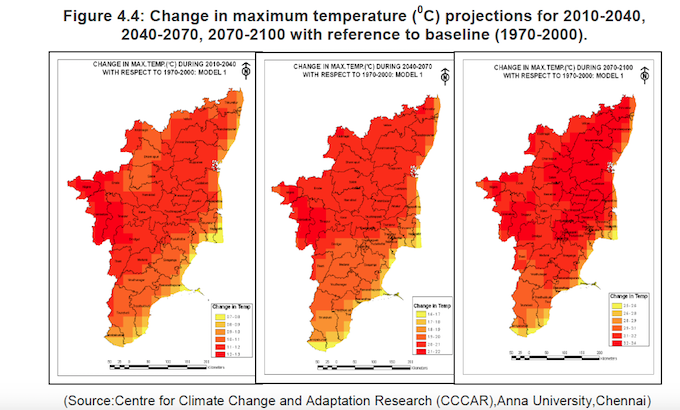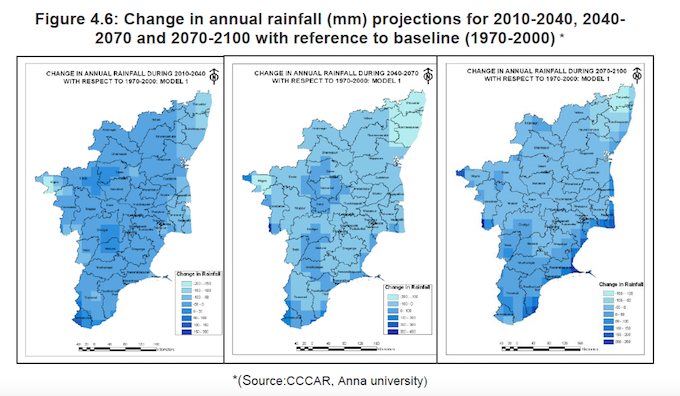A discernible trend of increasing temperatures and declining rainfall, coupled with more intense cyclones and floods, is disrupting life across Tamil Nadu, which is currently battling a drought

The queue of trucks at a water filling station in Chennai is going to grow in the coming months. (Photo by S. Gopikrishna Warrier)
For a few months after the November-December 2015 floods that submerged Chennai and adjoining districts in Tamil Nadu, people of the city were wary about rain forecasts. About a year later, in the middle of January 2017, residents of the city and the state are anxiously awaiting news of movement of rain-bearing clouds in the coming days.
This pendulum-like swing of people’s approach to rain from fear to anxious waiting signifies the volatility of weather patterns in Tamil Nadu. The impending drought this summer is the third consecutive weather-related event that the state has faced in the past 15 months. The floods of end-2015 and Cyclone Vardah, which caused huge loss of property due to high-velocity winds, are the other two events. If this period is an indication, Tamil Nadu could be at the receiving end of high intensity events related to climate change.
The Tamil Nadu State Action Plan on Climate Change (TNSAPCC) predicts that the state could have climate-related events of higher intensity in the coming years. Quoting studies carried out by the Centre for Climate Change and Adaptation Research (CCCAR) of Anna University, TNSAPCC states that the average annual maximum temperature for Tamil Nadu could increase by 3.1°C by 2100 from the baseline of 1970-2000. Similarly, the average annual minimum temperature could increase by 3.5°C. Average annual rainfall, on the other hand, could reduce by up to 9%. The rainfall pattern could shift more towards the northeast monsoon, which could bring more intense cyclones and floods.

The current drought in the state is the third back-to-back climate-related event in the past months. The Tamil Nadu Government had declared all the 32 districts of the state as drought-affected on January 10. As a response to this situation, the state government has sought drought support of up to INR 395.65 billion (USD 5.8 billion) from the National Disaster Response Fund of the Government of India. Of this, it wanted INR 10 billion released immediately for urgent action that needs to be taken to deal with the drought.
Tamil Nadu, like its neighbouring states Kerala and Karnataka, missed receiving the full share of the southwest and northeast monsoons in 2016. According to India Meteorological Department, Tamil Nadu and Puducherry region received 258.1 mm of rain during the southwest monsoon (June to September), when it should have received 317.2 mm, a deficit of 19%.
However, the big blow was with the northeast monsoon, the mainstay for most of Tamil Nadu. On January 16, Tamil Nadu Chief Minister O. Panneerselvam wrote a letter to Prime Minister Narendra Modi, in which he stated that during the northeast monsoon the state had received rainfall of 168.3 mm this season against the average of 440.4 mm, a deficit of 62%.

Situated on the leeward side of the Western Ghats, the southwest monsoon does not have the same impact in Tamil Nadu as in the other states of the country. The northeast monsoon contributes 50.7% of the rainfall in the state, and the southwest monsoon contributes 31.9%. Winter and pre-monsoon rains contribute the remaining 17.4%.
The consequence of the northeast monsoon providing most amount of rain for the state is the problem that much of the rainfall happens in a three-month period between October and December, leaving rest of the year dry. This would have been a non-issue if the rivers flowing through the state carried water all through the year. Unfortunately, it is not so, since only two rivers in the state are perennial — Cauvery and Thamirabarani. Only these two rivers originating from the evergreen forests of Western Ghats that can sustain the flow of water throughout the year in the state.
Of these two perennial rivers, only Thamirabarani has its catchment in Tamil Nadu. The state is a lower riparian for Cauvery, and since its catchment in Kodagu district of Karnataka had a deficit of 32% during the southwest monsoon, the water released to the delta region in Tamil Nadu has been inadequate.
Farmer distress
According to the Tamil Nadu Government, instead of the total quantum of 179 thousand million cubic feet (Tmcft) of water, which was to be released by Karnataka from June 1 to December 31, it released only 66.5 Tmcft of water, which left grossly insufficient water in the river. Farmers in the Cauvery delta were unable to raise even a single crop of paddy. The tanks and reservoirs in the state, on the other hand, are holding only 13% of their capacity. The state has officially confirmed the suicide of 17 farmers due to drought.
The swings between floods, cyclones and drought could become more intense in the decades to come for Tamil Nadu due to climate change. The CCCAR carried out a study for the Tamil Nadu Government in collaboration with the UK Met Office Hadley Centre, using their Providing Regional Climates for Impacts Studies (PRECIS) regional climate model. The CCCAR team ran the macro-level models that the assessment reports 4 and 5 of the Intergovernmental Panel on Climate Change (IPCC AR4 and IPCC AR5) developed. This allowed developing climate change models for Tamil Nadu at a resolution of 25 km.
In a paper published in the Theoretical and Applied Climatology journal, the CCCAR team notes that over the decades leading to 2100, combined with the increase in temperature there would be an overall reduction in rainfall in the state. The rainfall in the southwest monsoon (which is gentler and spread out across months) will be decrease while there could be increase in the cyclone-like rainfall events during the northeast monsoon (which is already the shorter-duration high rainfall period).

The modelling was done after taking the mid-level emission scenario for emission increase for Tamil Nadu. This is the A1B scenario for IPCC AR4, corresponding with the Representative Concentration Pathway (RCP) 4.5 scenario of IPCC AR5.
Increasing temperatures, declining rainfall
For Tamil Nadu as a whole, the projections of maximum temperature show an increase of 1.0, 2.2 and 3.1 °C for the periods 2020s (2005–2035), 2050s (2035–2065) and 2080s (2065–2095), respectively, with respect to baseline period (1970–2000). Similarly, the projections of minimum temperature show an increase of 1.1, 2.4 and 3.5 °C, respectively, for the similar period bands.
The annual rainfall projections for the same periods indicate a general decrease in rainfall of about 2–7, 1–4 and 4–9 %, respectively. There are also indications of increasing heavy rainfall events during the northeast monsoon season and a slight decrease during the southwest monsoon season. The High Altitude agro-climatic zone of the Western Ghats and the Eastern Ghats, and the High Rainfall agro-climatic zone near the tip of the peninsula could have an increase in rainfall from 10% to 25%.
